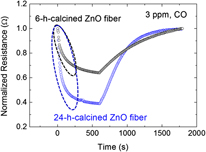Crossref Citations
This article has been cited by the following publications. This list is generated based on data provided by
Crossref.
Katoch, Akash
Sun, Gun-Joo
Choi, Sun-Woo
Byun, Joon-Hyuk
and
Kim, Sang Sub
2013.
Competitive influence of grain size and crystallinity on gas sensing performances of ZnO nanofibers.
Sensors and Actuators B: Chemical,
Vol. 185,
Issue. ,
p.
411.
Agarwal, Seema
Greiner, Andreas
and
Wendorff, Joachim H.
2013.
Functional materials by electrospinning of polymers.
Progress in Polymer Science,
Vol. 38,
Issue. 6,
p.
963.
Nikfarjam, Alireza
Fardindoost, Somayeh
and
Iraji zad, Azam
2013.
Fabrication of Pd Doped WO3 Nanofiber as Hydrogen Sensor.
Polymers,
Vol. 5,
Issue. 1,
p.
45.
Katoch, Akash
Choi, Sun-Woo
Sun, Gun-Joo
and
Kim, Sang Sub
2013.
An approach to detecting a reducing gas by radial modulation of electron-depleted shells in core–shell nanofibers.
Journal of Materials Chemistry A,
Vol. 1,
Issue. 43,
p.
13588.
Wang, Xueqin
Li, Yan
and
Ding, Bin
2014.
Electrospun Nanofibers for Energy and Environmental Applications.
p.
267.
Katoch, Akash
Choi, Sun-Woo
and
Sub Kim, Sang
2014.
Effect of the wall thickness on the gas-sensing properties of ZnO hollow fibers.
Nanotechnology,
Vol. 25,
Issue. 45,
p.
455504.
Katoch, Akash
Byun, Joon-Hyuk
Choi, Sun-Woo
and
Kim, Sang Sub
2014.
One-pot synthesis of Au-loaded SnO2 nanofibers and their gas sensing properties.
Sensors and Actuators B: Chemical,
Vol. 202,
Issue. ,
p.
38.
Viter, Roman
Katoch, Akash
and
Kim, Sang Sub
2014.
Grain size dependent bandgap shift of SnO2 nanofibers.
Metals and Materials International,
Vol. 20,
Issue. 1,
p.
163.
Nikfarjam, Alireza
and
Salehifar, Nahideh
2015.
Visible Light Activation in TiO<sub>2</sub>/Pd/N/Fe<sub>2</sub>O<sub>3</sub> Nanofiber Hydrogen Sensor.
IEEE Sensors Journal,
Vol. 15,
Issue. 10,
p.
5962.
Katoch, Akash
Choi, Sun-Woo
and
Kim, Sang Sub
2015.
Nanograins in electrospun oxide nanofibers.
Metals and Materials International,
Vol. 21,
Issue. 2,
p.
213.
Nikfarjam, Alireza
and
Salehifar, Nahideh
2015.
Improvement in gas-sensing properties of TiO2 nanofiber sensor by UV irradiation.
Sensors and Actuators B: Chemical,
Vol. 211,
Issue. ,
p.
146.
Yin, Mingli
and
Liu, Shengzhong
2016.
Synthesis of CuO microstructures with controlled shape and size and their exposed facets induced enhanced ethanol sensing performance.
Sensors and Actuators B: Chemical,
Vol. 227,
Issue. ,
p.
328.
Diao, Kaidi
Huang, Yunpeng
Zhou, Minjie
Zhang, Jicheng
Tang, Yongjian
Wang, Shuxia
Liu, Tianxi
and
Cui, Xudong
2016.
Selectively enhanced sensing performance for oxidizing gases based on ZnO nanoparticle-loaded electrospun SnO2 nanotube heterostructures.
RSC Advances,
Vol. 6,
Issue. 34,
p.
28419.
Katoch, Akash
Abideen, Zain Ul
Kim, Hyoun Woo
and
Kim, Sang Sub
2016.
Grain-Size-Tuned Highly H2-Selective Chemiresistive Sensors Based on ZnO–SnO2 Composite Nanofibers.
ACS Applied Materials & Interfaces,
Vol. 8,
Issue. 4,
p.
2486.
Mu, Haichuan
Wang, Keke
and
Xie, Haifen
2016.
Effects of the fabrication temperature and oxygen flux on the properties and nitrogen dioxide sensitivity of the tin oxides-tin/graphene hybrid sensor.
Journal of Materials Research,
Vol. 31,
Issue. 14,
p.
1993.
Katoch, Akash
Abideen, Zain Ul
Kim, Jae-Hun
and
Kim, Sang Sub
2016.
Influence of hollowness variation on the gas-sensing properties of ZnO hollow nanofibers.
Sensors and Actuators B: Chemical,
Vol. 232,
Issue. ,
p.
698.
Katoch, Akash
Abideen, Zain Ul
Kim, Jae-Hun
and
Kim, Sang Sub
2016.
Crystallinity dependent gas-sensing abilities of ZnO hollow fibers.
Metals and Materials International,
Vol. 22,
Issue. 5,
p.
942.
Palneedi, Haribabu
Park, Jung Hwan
Maurya, Deepam
Peddigari, Mahesh
Hwang, Geon‐Tae
Annapureddy, Venkateswarlu
Kim, Jong‐Woo
Choi, Jong‐Jin
Hahn, Byung‐Dong
Priya, Shashank
Lee, Keon Jae
and
Ryu, Jungho
2018.
Laser Irradiation of Metal Oxide Films and Nanostructures: Applications and Advances.
Advanced Materials,
Vol. 30,
Issue. 14,
Manjunath, G.
Nagaraju, P.
and
Mandal, Saumen
2021.
Ultra-sensitive clogging free combustible molecular precursor-based screen-printed ZnO sensors: a detection of ammonia and formaldehyde breath markers.
Journal of Materials Science: Materials in Electronics,
Vol. 32,
Issue. 5,
p.
5713.
Duy, Le Thai
Baek, Ji-Ye
Mun, Ye-Ji
and
Seo, Hyungtak
2021.
Patternable production of SrTiO3 nanoparticles using 1-W laser directly on flexible humidity sensor platform based on ITO/SrTiO3/CNT.
Journal of Materials Science & Technology,
Vol. 71,
Issue. ,
p.
186.



